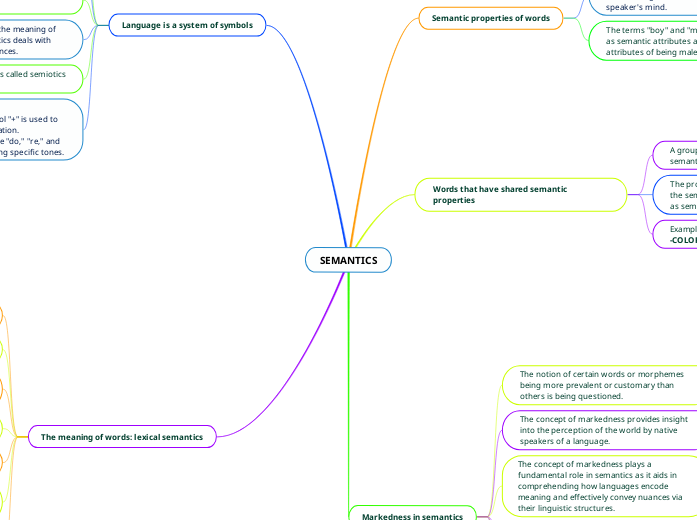SEMANTICS
Semantic properties of words
The elements of meaning that compose the mental image of the word reside within the speaker's mind.
The terms "boy" and "man" can be identified as semantic attributes associated with the attributes of being male and being human.
Words that have shared semantic properties
A grouping of words that possess common semantic characteristics.
The process of analyzing and breaking down the semantic properties of a word is known as semantics property analysis.
Examples:
-COLORS: Red, blue, green, yellow, purple
Markedness in semantics
The notion of certain words or morphemes being more prevalent or customary than others is being questioned.
The concept of markedness provides insight into the perception of the world by native speakers of a language.
The concept of markedness plays a fundamental role in semantics as it aids in comprehending how languages encode meaning and effectively convey nuances via their linguistic structures.
This supports linguists in examining how different linguistic elements relate to each other and how these choices affect how language is understood.
The analysis of how languages express meaning through the choice of marked and unmarked forms is a widely used concept in the field of linguistics.
Example of ender Markedness: actor, actress.
Language is a system of symbols
The symbol is not the thing that it represents and it is free to be anything.
A symbol can be used to create real or prevaricated concepts and represent abstractions.
Index has a causal relationship to what it indicates.
Lexical semantics deals with the meaning of words and structural semantics deals with the meaning of larger utterances.
Study of signs and symbols is called semiotics
Examples:
1. In mathematics, the symbol "+" is used to represent the addition operation.
2. In music, musical notes like "do," "re," and "mi" are symbols representing specific tones.
The meaning of words: lexical semantics
In each person's brain there is a lexicon.
Some words have an actual concrete concept called referent.
The referential meaning describes the referent. The referential meaning of a word is its definition.
Words can also refer to prevaricated things and abstract concepts
Sense allows us to understand words that have no concrete referent.
Shitting referents are different for each speaker and each sentence. Pronouns have shifting referents.
Some words do not have a referent, but instead express relationships or characteristics. Examples: The word "apple" can refer to a fruit, but it can shift its reference to a brand of electronic products.
